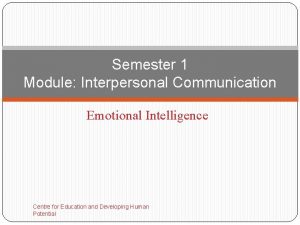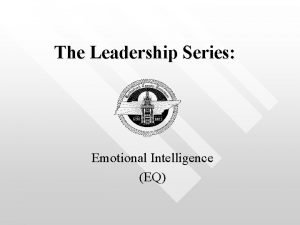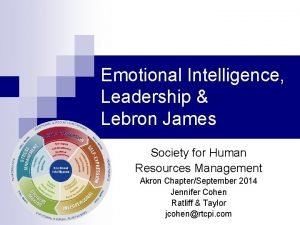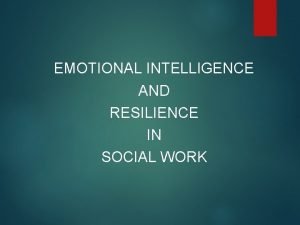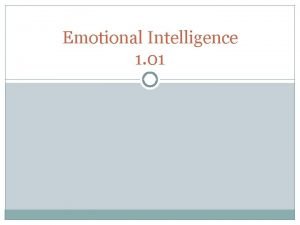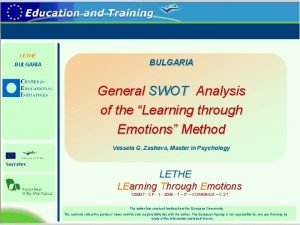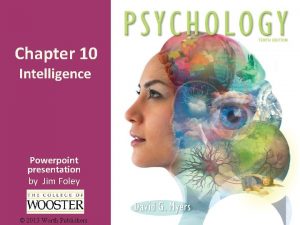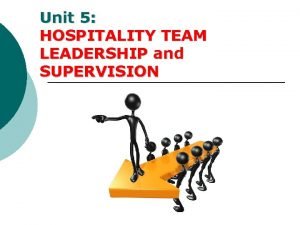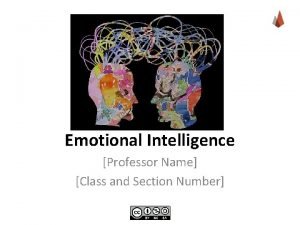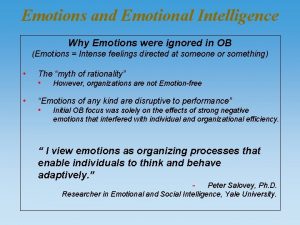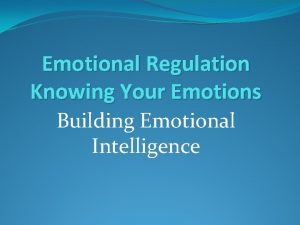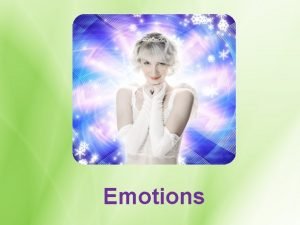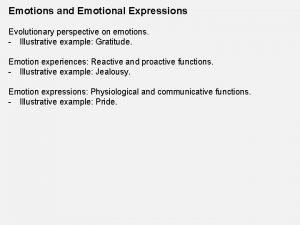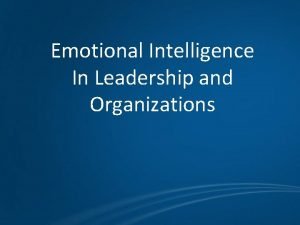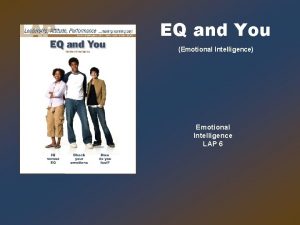Chapter 2 Emotions and Developing Emotional Intelligence in























- Slides: 23

Chapter 2 Emotions and Developing Emotional Intelligence in Tourism and Hospitality Businesses COMPLIMENTARY TEACHING MATERIALS

LEARNING OBJECTIVES • Understand the concepts of feelings and emotions. • Explain the relationship between emotions and service encounters in tourism and hospitality. • Explain the components of emotional intelligence in relation to service encounters. • Understand how emotional intelligence can be developed. COMPLIMENTARY TEACHING MATERIALS

Emotions The human brain has a tendency to carry out emotional processing rather than rational processing (Amaral et al. , 1992; Mc. Donald, 1998; Baker et al. , 2006). The number of signals coming from the rational part of the brain (the prefrontal cortex) is significantly lower (about one-tenth) than the number coming from the emotional part of the brain (the limbic system) (Hawkins and Blakeslee, 2004). COMPLIMENTARY TEACHING MATERIALS

Emotions • Emotions are the organised psychophysiological responses of individuals to stimuli in the environment (Scherer, 2003). • Anthropologists: emotions have developed as reactions to stimuli in the environment to promote specific actions through which individuals satisfy their needs and increase their possibility of survival (Fredrickson, 2001; Kuppens et al. , 2008). COMPLIMENTARY TEACHING MATERIALS

Emotions • Darwin: emotions – the appropriate reactions to events, especially to emergencies in the environment – increased the survival and adaptability of human beings and animals (Plutchick, 1984). • For example, fear and anger as facial expressions are the responses to aversive and threatening stimuli in the environment (Marsh et al. , 2005) and influence fight and flight responses of the individual. COMPLIMENTARY TEACHING MATERIALS

Eight Basic Emotions Emotion Related feeling Explanation Fear Feeling of being afraid Anger Feeling of being angry. Anger is a learned and A cold dinner or dinner not cooked When anger is extreme inherited response, and is according to customer request may anger it is called rage common to all human the customer. societies and animals. Anger comes about when people are threatened, offended, wronged, or denied something they really want or need. COMPLIMENTARY TEACHING MATERIALS Fear comes from sensing danger. Someone who fears something does not want it to happen. Feeling of fear results in the fightor-flight response. Service encounter explanations and examples There may be various risk hazards in a tourism and hospitality business. An unsafe lift or exposed power cables in a hotel room may cause customers to feel physiological risk. There are other types of risks such as financial, psychological, social, performance and time risks, which may cause the customer to feel fear.

Eight Basic Emotions Emotion Related feeling Sadness Explanation Service encounter explanations and examples Feeling of being sad It is the opposite of happiness. Other words similar to sadness are sorrow and grief A holiday that does not meet the expectations of a customer may anger the customer and may make her/him feel disappointed and sad Feeling of being happy The feeling of happiness is associated with pleasure and positivity. Someone can be said to be happy if s/he feels relieved, relaxed satisfied, proud and good. Although happiness is considered to be the opposite of sadness, it is possible to feel both sadness and happiness at the same time A recovered service failure at a restaurant or an unexpected kind gesture from a service employee at a hotel may cause the customer to feel joy Joy COMPLIMENTARY TEACHING MATERIALS

Eight Basic Emotions Emotion Related feeling Explanation Disgust Surprise Service encounter explanations and examples Feeling that something When people see, touch, is wrong or nasty hear or taste something nasty or repulsive, they feel disgusted Unaccustomed foodstuff from a different culture or a lack of hygiene in a restaurant may cause a feeling of disgust Feeling of being unprepared for something Customer delight comes from surprising a customer by exceeding her/his expectations. When a customer is offered a free welcome drink in a restaurant, s/he may be happy due to the arousal occurring as a result of this unexpected gesture of generosity. As in the case of the service recovery paradox, surprise produces arousal. COMPLIMENTARY TEACHING MATERIALS When a person feels something unexpected has happened or may happen s/he may feel surprised. A surprise may be pleasant, unpleasant, positive or negative. An intense unpleasant or negative surprise may cause the person to choose the fight or flight response.

Eight Basic Emotions Emotion Related feeling Explanation Service encounter explanations and examples Trust Feeling of reliability towards somebody or something Trust is a feeling that somebody or something can be relied upon, or will turn out to be good. It is the feeling of being sure about something, even if it cannot be proved. Trust is important in service encounters. Trust lies at the centre of two of the SERVQUAL elements of reliability and assurance. A feeling of positive expectation Anticipation involves a positive attitude and looking forward to something which may happen While a certain level of anticipation of customers regarding service encounters is necessary, increased levels of anticipation may have detrimental effects Anticipation COMPLIMENTARY TEACHING MATERIALS

The Main Constructs of Emotional Intelligence Construct Explanation Self-awareness Ability to read emotions and be aware of their impact Self-management Ability to manage and control emotions and impulses and the ability to adapt to change Social awareness Ability to feel, understand react to others’ emotions; understanding social networks Relationship management Ability to inspire, motivate, influence and develop others; manage conflict COMPLIMENTARY TEACHING MATERIALS

Abilities of Emotional Intelligence Ability Explanation Perceiving emotions Ability to identify, decode and discern emotions in facial and expressions, body language pictures, voices and cultural artefacts Ability to control emotions to aid diverse cognitive activities, such as thinking and problem-solving Ability to understand emotions and feelings, the underlying reasons for them and relationship between them Ability to manage her/his emotions as well as others’ Using emotions Understanding emotions Managing emotions COMPLIMENTARY TEACHING MATERIALS

The Role of Emotional Intelligence for Service Personnel and Service Quality Skill Explanation Self. Having a deep awareness understanding of one’s emotions, strengths, weaknesses, needs and drives, as well as their effect on others COMPLIMENTARY TEACHING MATERIALS Characteristics Relation to Service Personnel Relation to SERVQUAL Dimensions Self-confidence, realistic selfassessment, selfdeprecating sense of humour Ability to understand her/his role in service encounters Responsiveness Ability to know her/his abilities, limits and weaknesses when making claims to solve problems Assurance Reliability Empathy

The Role of Emotional Intelligence for Service Personnel and Service Quality Skill Explanation Selfregulation Ability to control or Trustworthiness, redirect disruptive integrity, comfort impulses and with ambiguity, moods and the openness to propensity to change suspend judgment – thinking before acting COMPLIMENTARY TEACHING MATERIALS Characteristics Relation to Service Relation to Personnel SERVQUAL Dimensions Ability to Reliability understand Responsiveness evaluate service Assurance failures Ability to think and Empathy implement new approaches to deal with service failures

The Role of Emotional Intelligence for Service Personnel and Service Quality Skill Explanation Characteristics Relation to Service Personnel Relation to SERVQUAL Dimensions Motivation A passion to work for reasons that go beyond money or status, with a propensity to pursue goals with energy and persistence Strong desire to achieve, optimism (even in the face of failure), organizational commitment Ability to cope with heavy demands of frequent and intense social interactions. Unyielding approach towards service failures. Commitment to service quality and maintaining a strong the image of service business Responsiveness COMPLIMENTARY TEACHING MATERIALS Reliability Assurance Empathy

The Role of Emotional Intelligence for Service Personnel and Service Quality Skill Explanation Characteristics Relation to Service Personnel Relation to SERVQUAL Dimensions Empathy Ability to understand the emotional makeup of other people, with skill in treating people according to their emotional reactions Service towards customers and clients, crosscultural sensitivity, expertise in building and retaining talent Empathy Ability to understand the needs and expectations of customers – including customers from other cultures Service orientation Empathy towards the feelings of customers during service encounters Handling complaints and conflicts Handling difficult customers COMPLIMENTARY TEACHING MATERIALS Responsiveness Assurance Reliability

The Role of Emotional Intelligence for Service Personnel and Service Quality Skill Explanation Characteristics Relation to Service Personnel Social skill Proficiency in managing relationships and building networks, with an ability to find common ground and build rapport Managing relationships and building networks, with an ability to find common ground and build rapport Ability to manage social interactions effectively during service encounters COMPLIMENTARY TEACHING MATERIALS Relation to SERVQUAL Dimensions Responsiveness Assurance Reliability Empathy Ability to use help from networks of people from other departments to solve problems

Perceiving/Understanding Emotions/Facial Expressions Visit the following web pages and study the facial expression photos and the information provided there: Ø https: //listverse. com/2013/07/05/ten-compellingorigins-of-our-facial-expressions/ Ø https: //imotions. com/blog/facial-expression-analysis/ • COMPLIMENTARY TEACHING MATERIALS

Perceiving/Understanding Emotions/Facial Expressions COMPLIMENTARY TEACHING MATERIALS

Exercises to Develop Emotional Intelligence Ability Explanation Exercises Using emotions Ability to control emotions to aid diverse cognitive activities, such as thinking and problem solving Exercise: write down ten negative sentences such as ‘You have disappointed me’, ‘You have made me angry’. Then rephrase them with sentences such as ‘I feel disappointed’ and ‘I feel angry’. This exercise will help you own your feelings rather than blaming others COMPLIMENTARY TEACHING MATERIALS

Using and Managing Emotions How to feel more confident: • Stand or sit up straight • If sitting, keeping elbows on the arms of the chair (rather than putting them tightly against your sides) • Hold hands palm down on the lap or on the table • Keep head level • Make appropriate eye contact • Relax shoulders • Lower the pitch of the voice • If standing, spread weight evenly between both legs. If sitting, uncross legs, put both feet flat on the floor • Speak more slowly COMPLIMENTARY TEACHING MATERIALS

Exercises to Develop Emotional Intelligence Ability Explanation Exercises Understanding emotions Ability to understand emotions, feelings and their underlying reasons, and understand appreciate the relationship among complicated emotions Exercise 1: think of the exercise provided above for ‘perceiving emotions’, and this time when you are watching and listening, try to make sure to do the following: Look for more than one clue 1) 2) 3) Take the context into account Look out for any changes in the emotions evident in verbal and non-verbal communication Think about the reasons why people feel the way they do Frequently practice your ability to ‘read’ other people. COMPLIMENTARY TEACHING MATERIALS

Exercises to Develop Emotional Intelligence Ability Explanation Exercises Understanding emotions Ability to understand emotions, feelings and their underlying reasons, and understand appreciate the relationship among complicated emotions Exercise 2: next time you are in a restaurant, try to monitor other restaurant customers and staff. Particularly try to identify: • • • Customers who are happy/unhappy with their food Staff who are making fake gestures Customers who are trying to get the attention of the waiter Customers who are tense and disappointed Staff who are weary, tired or stressed Staff who are lively and joyful • • • Think about the reasons why people feel the way they do COMPLIMENTARY TEACHING MATERIALS

Exercises to Develop Emotional Intelligence Ability Explanation Exercises Managing emotions Ability to manage her/his Think of two situations; one in which you had emotions as well as positive emotions and the other in which you had others’. negative emotions. For each of these: 1) 2) 3) COMPLIMENTARY TEACHING MATERIALS Identify your triggers – for instance, what can suddenly make you angry, frustrated? What sort of situations make feel disappointed? Think about your physical feelings, thoughts and behaviour in these situations. For instance – physical feelings: you may breathe quickly, feel tense, you may feel your heart beating Think about ways to change your thoughts, physical feelings and behaviour
 Attitude and emotional intelligence
Attitude and emotional intelligence Interpersonal communication and emotional intelligence
Interpersonal communication and emotional intelligence Objectives of emotional intelligence
Objectives of emotional intelligence Oka emotional intelligence
Oka emotional intelligence Global leadership foundation emotional intelligence test
Global leadership foundation emotional intelligence test Master aptitude emotional intelligence
Master aptitude emotional intelligence Emotional intelligence index
Emotional intelligence index Emotional intelligence happiness
Emotional intelligence happiness Emotional intelligence flowchart
Emotional intelligence flowchart Emotional intelligence training materials
Emotional intelligence training materials Emotional intelligence in social work
Emotional intelligence in social work 4 domains of emotional intelligence
4 domains of emotional intelligence Tows matrix cp all
Tows matrix cp all Emotional quotient
Emotional quotient Advantages of emotional intelligence
Advantages of emotional intelligence Emotional intelligence in hrm
Emotional intelligence in hrm Emotional intelligence ppt
Emotional intelligence ppt Evolution of emotional intelligence
Evolution of emotional intelligence Blueeq emotional intelligence
Blueeq emotional intelligence Conclusion of emotional intelligence
Conclusion of emotional intelligence Evolution of emotional intelligence
Evolution of emotional intelligence Emotional intelligence speaker
Emotional intelligence speaker Emotional intelligence presentation
Emotional intelligence presentation High emotional intelligence
High emotional intelligence

